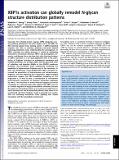| dc.contributor.author | Wong, Madeline Y. | |
| dc.contributor.author | Dewal, Mahender | |
| dc.contributor.author | Taylor, Rebecca J. | |
| dc.contributor.author | Whittaker, Charles A. | |
| dc.contributor.author | Phyo, Pyae | |
| dc.contributor.author | Shoulders, Matthew D. | |
| dc.contributor.author | Chen, Kenny,Ph. D.Massachusetts Institute of Technology. | |
| dc.date.accessioned | 2020-05-28T18:49:56Z | |
| dc.date.available | 2020-05-28T18:49:56Z | |
| dc.date.issued | 2018-10 | |
| dc.identifier.issn | 0027-8424 | |
| dc.identifier.uri | https://hdl.handle.net/1721.1/125565 | |
| dc.description.abstract | Classically, the unfolded protein response (UPR) safeguards secretory pathway proteostasis. The most ancient arm of the UPR, the IRE1-activated spliced X-box binding protein 1 (XBP1s)-mediated response, has roles in secretory pathway maturation beyond resolving proteostatic stress. Understanding the consequences of XBP1s activation for cellular processes is critical for elucidating mechanistic connections between XBP1s and development, immunity, and disease. Here, we show that a key functional output of XBP1s activation is a cell type-dependent shift in the distribution of N-glycan structures on endogenous membrane and secreted proteomes. For example, XBP1s activity decreased levels of sialylation and bisecting GlcNAc in the HEK293 membrane proteome and secretome, while substantially increasing the population of oligomannose N-glycans only in the secretome. In HeLa cell membranes, stress-independent XBP1s activation increased the population of high-mannose and tetraantennary N-glycans, and also enhanced core fucosylation. mRNA profiling experiments suggest that XBP1s-mediated remodeling of the N-glycome is, at least in part, a consequence of coordinated transcriptional resculpting of N-glycan maturation pathways by XBP1s. The discovery of XBP1s-induced N-glycan structural remodeling on a glycome-wide scale suggests that XBP1s can act as a master regulator of N-glycan maturation. Moreover, because the sugars on cell-surface proteins or on proteins secreted from an XBP1s-activated cell can be molecularly distinct from those of an unactivated cell, these findings reveal a potential new mechanism for translating intracellular stress signaling into altered interactions with the extracellular environment. | en_US |
| dc.description.sponsorship | Institute of Environmental Health Sciences (Grant P30-ES002109) | en_US |
| dc.description.sponsorship | National Cancer Institute (U.S.) (Grant P30-CA14051) | en_US |
| dc.language.iso | en | |
| dc.publisher | Proceedings of the National Academy of Sciences | en_US |
| dc.relation.isversionof | https://dx.doi.org/10.1073/PNAS.1805425115 | en_US |
| dc.rights | Article is made available in accordance with the publisher's policy and may be subject to US copyright law. Please refer to the publisher's site for terms of use. | en_US |
| dc.source | PNAS | en_US |
| dc.title | XBP1s activation can globally remodel N-glycan structure distribution patterns | en_US |
| dc.type | Article | en_US |
| dc.identifier.citation | Wong, Madeline Y. et al. “XBP1s activation can globally remodel N-glycan structure distribution patterns.” Proceedings of the National Academy of Sciences 115 (2018): E10089-E10098 © 2018 The Author(s) | en_US |
| dc.contributor.department | Massachusetts Institute of Technology. Department of Chemistry | en_US |
| dc.contributor.department | Koch Institute for Integrative Cancer Research at MIT | en_US |
| dc.relation.journal | Proceedings of the National Academy of Sciences of the United States of America | en_US |
| dc.eprint.version | Final published version | en_US |
| dc.type.uri | http://purl.org/eprint/type/JournalArticle | en_US |
| eprint.status | http://purl.org/eprint/status/PeerReviewed | en_US |
| dc.date.updated | 2020-01-14T13:00:58Z | |
| dspace.date.submission | 2020-01-14T13:01:00Z | |
| mit.journal.volume | 115 | en_US |
| mit.journal.issue | 43 | en_US |
| mit.metadata.status | Complete | |
